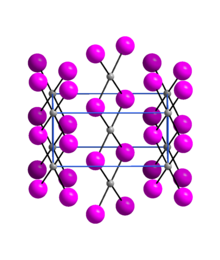Palladium(II) iodide

| |
| Identifiers | |
|---|---|
3D model (JSmol)
|
|
| ChemSpider | |
| ECHA InfoCard | 100.029.276 |
| EC Number |
|
PubChem CID
|
|
CompTox Dashboard (EPA)
|
|
| |
| |
| Properties | |
| I2Pd | |
| Molar mass | 360.229 g/mol |
| Appearance | Black crystals |
| Density | 6,003 g/cm3 |
| Melting point | 350 °C (decomposes) |
| Insoluble in water | |
| Hazards | |
| GHS labelling:[1] | |

| |
Signal word
|
Warning |
| H315, H319, H335 | |
| Related compounds | |
Other anions
|
Palladium(II) fluoride Palladium(II) chloride Palladium(II) bromide |
Except where otherwise noted, data are given for materials in their standard state (at 25 °C [77 °F], 100 kPa). | |
| Infobox references | |
Palladium(II) iodide is an inorganic compound of palladium and iodine. It is commercially available, though less common than palladium(II) chloride, the usual entry point to palladium chemistry.
Historically, the quantity of palladium in a sample may be determined gravimetrically by precipitation as palladium(II) iodide. Unlike the chloride and bromide, palladium(II) iodide is not quite as soluble in excess iodide.[2]
Properties[]
Palladium(II) iodide is insoluble in water by itself, but in the presence of excess iodide it may dissolve due to the formation of the PdI42− anion. While in solution it can act as a catalyst in some organic reactions.[3]
References[]
- ^ "C&L Inventory". echa.europa.eu. Retrieved 13 December 2021.
- ^ Beamish, F. E.; Dale, J. (1938). "Determination of Palladium by Means of Potassium Iodide". Industrial & Engineering Chemistry Analytical Edition. 10 (12): 697. doi:10.1021/ac50128a015.
- ^ Gabriele, Bartolo; Salerno, Giuseppe (2006), "Palladium(II) Iodide", Encyclopedia of Reagents for Organic Synthesis, American Cancer Society, doi:10.1002/047084289x.rn00658, ISBN 978-0-470-84289-8, retrieved 2021-03-26
Categories:
- Palladium compounds
- Iodides
- Platinum group halides